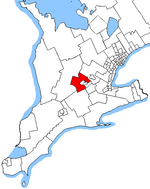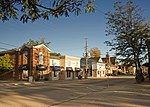Floradale, Ontario
Communities in the Regional Municipality of WaterlooUse Canadian English from January 2023Woolwich, Ontario

Floradale is an unincorporated rural community in Southwestern Ontario, Canada. It is part of the township of Woolwich in the Regional Municipality of Waterloo. The community is located 5 kilometres (3 miles) to the north of the town of Elmira, Ontario and 20 kilometres (12 miles) to the north of the city of Waterloo, Ontario. Canagagigue Creek, a tributary of the Grand River, flows through the village. The community is located in an area where there is an historically large settlement of Old Order Mennonites noted for their traditional customs, dress, and use of horse and buggies.
Excerpt from the Wikipedia article Floradale, Ontario (License: CC BY-SA 3.0, Authors, Images).Floradale, Ontario
Floradale Road, Woolwich
Geographical coordinates (GPS) Address Nearby Places Show on map
Geographical coordinates (GPS)
| Latitude | Longitude |
|---|---|
| N 43.635277777778 ° | E -80.579722222222 ° |
Address
Floradale Road 2273
N0B 1V0 Woolwich
Ontario, Canada
Open on Google Maps








